![How to Manage and Create a Change Request [Templates Included]](http://royalcdkeys.com/cdn/shop/articles/image4-1684588862273.jpg?v=1719561293&width=1100)
How to Manage and Create a Change Request [Templates Included]

Project managers will deal with changes every time. They are always bound to have some clients, team members, or other stakeholders asking for adjustments along the way. For this very reason, you need to track those changes. That's why change request forms play an important role in project management.
These documents track and ease managing change requests to see if those have been approved and implemented. It will cut you some time to follow up on change requests and give you more to spend on other duties.
In this article, you will learn how to create a change request and all the elements that compose one, and we also will give you some free templates to give you a head start on making your own change request form.
What are Change Requests
Change requests are a core element of the change management process. They act as formal documents and outline modifications to certain aspects of the project or business. They often are aimed at high-level operations, such as project deliverables or organizational concerns.
A change request can come from inside or outside the organization. While they can vary widely, the change request management process remains the same. This continuity will simplify creating, monitoring, submitting, and approving/denying them.
How Change Requests Work
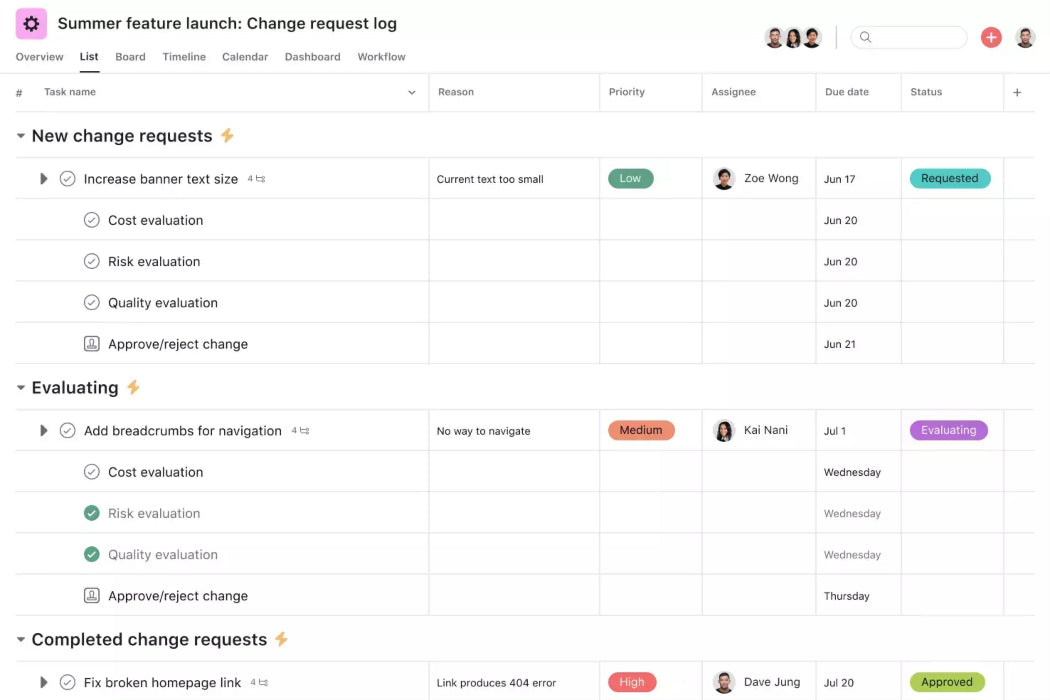
If a stakeholder wants to request a change, they must fill out a change request form with their most relevant details.
On the top of the form, some basic information should be included, like the project name, who submitted the request, and the date of such request. Whoever fills out the document needs to set the priority level of the change, define the impact that the change will produce on the project plan, and what could happen if the "change request approval" is denied.
Some project change requests could include a separate section for describing how such change will affect the following aspects of the whole project:
- Scope
- Cost
- Risk
- Duration
- Quality
Once your change request template is ready, you can use it repeatedly, making it easy to establish a change control process for every new project.
Types of Change Requests

Change requests can be divided into four categories, depending on the goal of the change. Each of these four types can apply to both projects and organizations as a whole.
Normal Change
A normal change request will address a significant change and modification to operations, infrastructure, existing systems, etc.
It implies substantial changes that need to be made. Normal change requests will often result in additional ones.
Standard Change
It proposes a low-risk change that would happen often. Many changes are natural throughout a business or project, and these changes can be thought of as evolution.
Standard change requests are proposals outlining what needs to be adjusted, but the adjustment itself will follow a pre-existing system.
Major Change
A major change request addresses a significant change that requires substantial financing.
Major changes will pose a high risk, but they could also bring high rewards. They don't occur often, and if they are poorly handled, they could seriously damage the project. However, they are necessary to do extreme modifications.
Emergency Change
It is a high-priority proposal for immediate change.
This type of change request often results from something not going as planned. It can be used to prevent such unexpected circumstances from damaging the project and wreaking havoc on the organization.
Key Steps for the Change Management Process
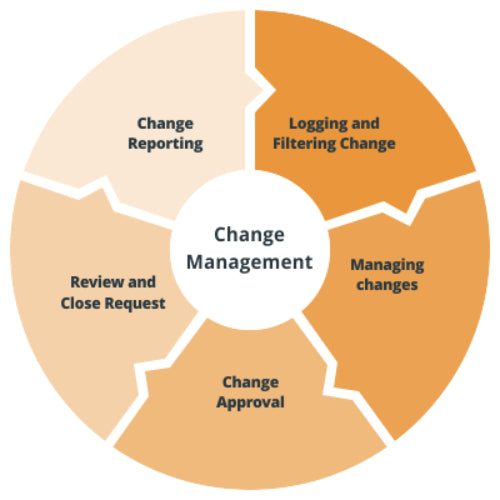
Understanding how change requests work on a project and how they are dealt with within an organization, how can you manage change requests and implement them at your business?
Below you will find several key steps to take to get started on creating a strong change request template.
Understanding the Scope of the Change
The first step of a change request process is to understand the project’s scope and what will be needed to implement it.
You must ensure that the change request process captures all the necessary information for you and the concerned stakeholders to make an informed decision about the requested change.
Defining the Impact of Such Change
Along with knowing and understanding the full scope of the change request, you have to determine and consider all the ramifications of incorporating such change.
You should ask yourself how it will impact the project budget and its timeline and how many team members and departments will be affected by this change request. These questions will help you, your project team, and your leadership decide whether it is right to approve this change request or if it should be denied or changed.
Seeking Approval
Organizations have different levels of approval. Smaller changes might only need approval from the project manager or the main sponsor. However, suppose such changes are more substantial and have a higher impact on the project. In that case, they will typically require approval from higher-level management.
Your business’ change request management process should lay down criteria for the different levels of change request approval.
Communicate and Implement the Change Request
Once the change request is approved, you must communicate that change to every team member of the project team and all the vested stakeholders and parties involved so they are all on the same page as you.
This also will mean following up with the client if such a change request originated from them.
Free Change Request Templates for Microsoft Word
With everything in place, you are ready to create your own change request form template. But to give you a head start (as starting one from scratch can be daunting), we will provide you with some great templates. You can adjust any of these in the way that best suits your needs. All that is required is to have Microsoft Word installed on your computer.
And if you need a CD key for Word, you can purchase one from the RoyalCDKeys digital store. You will find the latest version of Microsoft Office, which includes the whole package. That means you won't only get Word but also programs such as Excel, Outlook, PowerPoint, Access, and more.
One-Page Change Request Template
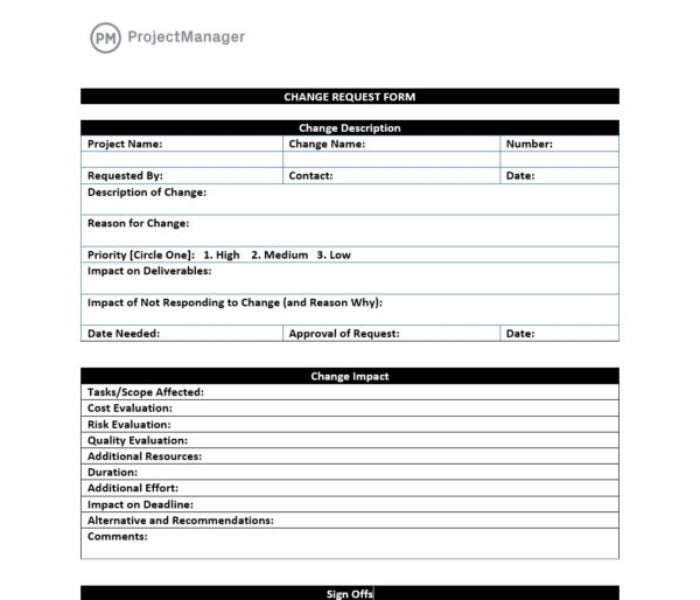
This one-page change request template captures every aspect of the change request in cells that can be expanded to include more details and information. Although such descriptions should be brief, the dynamism of the document will make it useful to any kind of project that you might be working on.
It has a place for all the information required: from the project name down to the impact it can produce. The manager should have enough information to discern the course of action or deny such.
You can download this template from ProjectManager.com.
Change Request Template
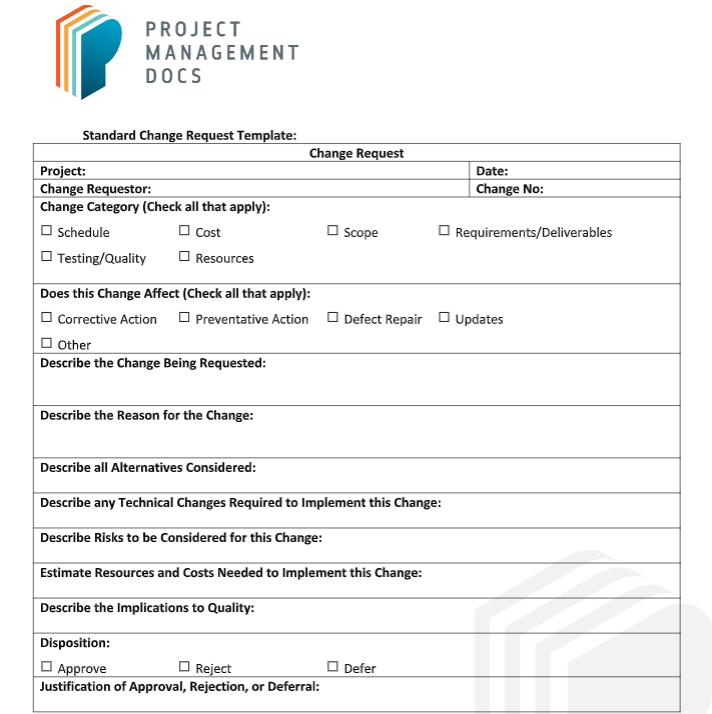
This template also covers all the main components of a change request. It simplifies the process by adding multiple choice to the "change category" and "change impact" sections for better visibility. While the rest could continue adding descriptions for every detail needed to better understand the change request.
You can download this template from Project Management Docs.
Simple Change Request Template
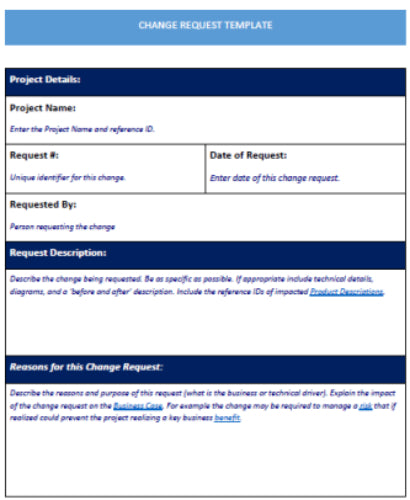
A much simpler and easy-to-understand template. It trades the look for more space for you to better explain the details of the change request without missing any main component that forms a change request template.
You can download this template from StakeholderMap.com.
Key Takeaways
Having the right processes in place to properly manage them is the best way to handle proposed changes to a project. Using the best template for you will ensure that none of the vital steps are missing and that stakeholders, together with any of the other team members, are on the same page as you.
Take the chance and download any of these templates to start making your change request forms and properly manage those for your project and organization needs.















